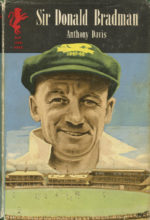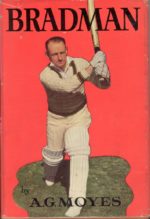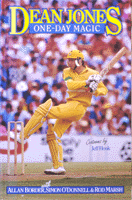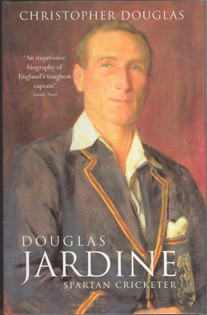No products in the cart.
Description
DR Jardine’s life story, hardback with dw
A more sympathetic English view of Jardine
Additional information
| Year Of Publication | |
|---|---|
| Other Notes |
1 review for Douglas, Christopher – Douglas Jardine, Spartan Cricketer
Add a review Cancel reply
You must be logged in to post a review.
Related products
-
Sale!

Nicholson, Rod – Merv Hughes, special price
$11.00Original price was: $11.00.$2.20Current price is: $2.20. Add to cart -

Davis, Anthony – Sir Donald Bradman (biography)
$22.00 Add to cart -

Moyes, AG ‘Johnnie’ – Bradman, original edition
$22.00 Add to cart -

Jones, Dean – One-Day Magic, cartoons by Jeff Hook
$13.75 Add to cart




Ken –
Review by MARK NELSON
Christopher Douglas. (1984, revised edition 2002). Douglas Jardine Spartan Cricketer.
The average cricket fan will know something about the game since they started following it but, I am sure, does not much care for cricket history. But then I suppose the average human does not much care for history. Still, it seems a good bet that the average cricket fan has heard of the Bodyline series. Indeed the average cricket fan will know something of the 1932-33 MCC tour of Australia, a.k.a the Bodyline series, for as long as test match cricket is played. It is likely that they will ascribe to the opinion that the villain of the piece was the MCC captain: Douglas Jardine (1900–1958). (It really was the Marylebone Cricket Club tour as outside the five test matches the team played under the MCC moniker.)
When Douglas was researching for the first edition of his book, it was still possible to interview contemporaries of Jardine who had played cricket with him or knew him. Indeed, three member of the 1932-1933 MCC team were interviewed: the amateur all-rounder, and subsequently very influential administrator, George “Grubby” Allen; the professional fast bowler Harold Larwood, and the amateur vice-captain R.E.S. Wyatt. However, such was the long shadow cast by the bodyline controversy that many of the interviewees said “Don’t put that in your book”. In view of the almost twenty years that had passed before the publication of the revised edition, i.e. the resulting deaths of the authors of such comments, Douglas no longer felt restrained “to withhold some of these far from scandalous but notably divergent opinions”.
Another indication of the length of the shadow cast by the Bodyline series is that the first edition of this book was the first biography of Jardine, one of only four English captain’s to regain the Ashes in Australia: Plum Warner (1903–1904), Johnny Douglas (1911–1912), and Ray Illingworth (1970–71) being the other captains to do so. If we extend the scope of the investigation to England captain’s to win an Ashes series in Australia, rather than regain the Ashes, then the additional captains, since Jardine, are: Len Hutton (1954–55), Mike Brearley (1978–79), Mike Gatting (1986–87), and Andrew Strauss (2010–11).
Jardine never accepted criticism of the tactics employed on the 1932–1933 tour. To him, there was nothing new in them. Leg theory, in which the bowler delivered the ball somewhere between the batsman’s left knee and shoulder and in which the bowler was supported by a cordon of fielders on the leg-side, had been employed in English cricket, off-and-on, for years. The Nottinghamshire fast-medium bowler Bill Voice, one of the touring party in 1932–33, had been bowling fast leg-theory for a couple of seasons in England. Fast leg theory had even been employed on an Australian tour by the MCC. Frank Foster, a fast medium bowler, had bowled it on the 1911–12 series, taking 32 wickets. Jardine had visited Foster before leaving England to learn the field placings Foster had used on the 1911–1912 tour.
If fast leg-theory had been tried before, tried over a number of decades, then what was new about its use in the 1932–33 season? It’s difficult to believe now, but there was a time when it was unusual for a team to have more than one fast bowler. The tactic was less intimidatory when it was only being bowled from one end and only for a limited time. Secondly, the tactic was not effective if the bowling was not accurate and the batsman did not have to play at every ball. In 1932 two Australian fast bowlers had bowled fast leg theory, John Scott (of New South Wales and then South Australia) and H.H. ‘Bull’ Alexander (of Victoria). Scott was not accurate and his bowling was expensive, the more so against the better batsmen.2 Alexander had even bowled bodyline to Jardine on the 1928–1929 MCC tour!
Thirdly, under English conditions fast leg theory was only dangerous if the pitch helped the bowler; often it didn’t. Fast leg theory when bowled under English conditions by the two fast medium bowlers Bill Bowes and Bill Voice was often just dull to watch. However, on the harder and faster pitches of Australia Bowes and Voice posed a much greater threat.
The fourth reason why the employment of fast leg theory on the 1932-33 tour changed cricket was Harold Larwood. Larwood was the greatest, and fastest, bowler of his generation. He was also a very accurate bowler. When Larwood bowled fast leg theory, every ball had to be played.
During the 1932–1933 tour, the hierarchy of the MCC gave their full support to Jardine, their touring team, and the tactics employed. They subsequently underwent a chance of heart and did a full U-turn. Scapegoats had to be found. Both Larwood and Voce were asked to apologise to the Australians for their actions, Larwood refused, and it is probable that pressure was similarly put on Jardine. Initially, Larwood and Jardine were viewed as the villains of the peace. Larwood would eventually be forgiven, even by the Australian public. He may have been forgiven by Australians, but the ruling classes in England have a long memory. It was only in June 1993 — sixty years later — that he received a MBE for services to cricket. (One of John Major’s best acts as Prime Minister?)
Recent decades have seen a reassessment of Jardine’s captaincy, at least by non-Australian cricket fans, and he is no longer viewed by many as a villain. If all’s fair in love and war, then it should not be forgotten that bodyline was legal at the time.
If Jardine is no longer a villain, then do we need a villain? If a villain is needed then we need look no further than the MCC itself. And if we need a face to put to the role of villain then the man to step forward for the role is the manager of the 1932-33 team, Plum Warner. In 1932 Warner had reported on the Surrey v. Yorkshire match at the Oval for the Morning Post.
Warner. . . had vehemently criticised his ((Bowes)) intimidatory tactics. . . Hobbs was on the receiving end of a concentrated short-pitched attack with five men on the leg side. He was hit several times, once on the head. . . ‘That is not bowling,’ wrote Warner in the Morning Post. ‘Indeed, it is not cricket…‘I appeal to Bowes and to others, if any, who may have influenced him to the his present style, to get him back to orthodoxy.’
Christopher Douglas. (1984, revised edition 2002). Douglas Jardine Spartan Crick- eter, pages 118–119.
2After Scott finished playing he became an umpire, standing as a first-class umpire for more than 50 games — including ten tests between 1936 and 1947. His wikipedia entry notes that “As an umpire, he earned a reputation for disciplining fast bowlers for bowling short rising deliveries — the type of bowling for which he had been known.”
3\This was his only test match.
Yet during the 1932–33 tour Warner kept quiet, despite being pressured by Australians to comment upon the tactics being employed. He kept quiet even after the Australian press discovered his writing on the Surrey v. Yorkshire match. In 1933, after the return of the touring team, the MCC had an inquiry into the events of the 1932–33 tour. Testimonies were heard from Jardine, the two managers, and several other players. Even though the MCC has never released the findings of the inquiry, circumstantial evidence suggests that “Warner’s report on the series was critical of Jardine and his tactics”. In fact it was no secret that Warner did not support bodyline and pressured members of the MCC to ban it.
More books have been published on the bodyline tour then any other Ashes series. It is difficult to believe that there is anything new to say, but I expect new books to appear in 2032 and 2033. But what of the MCC files? Elsewhere I’ve read that it’s known that many of the MCC files on the bodyline series have gone missing. This includes reports written by Jardine (as Captain), R.E.S. Wyatt (the vice-captain), G.O.B. “Gubby” Allen (the amateur who refused to bowl bodyline) and Warner. It is seemingly known that these documents went missing in the early 1940s, at a time when the cricket ground was requisitioned to become an Aircrew Receiving Centre.
At the start of the war Warner was appointed assistant deputy at Lord’s, being promoted to deputy secretary. He held this appointment, and accordingly ran Lord’s, throughout the war. Is it possible that he took the opportunity to purge the MCC files of anything that cast him in a bad light? The thought has crossed a few minds, but in legal terms the charge is not proven.